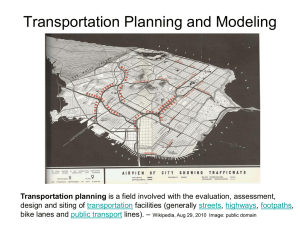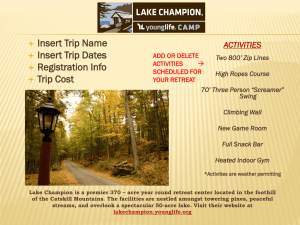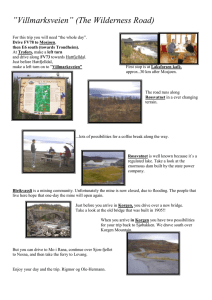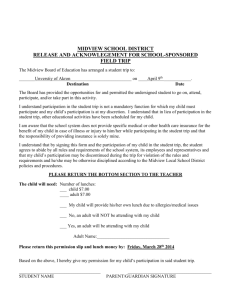Introduction to Packrafting
advertisement
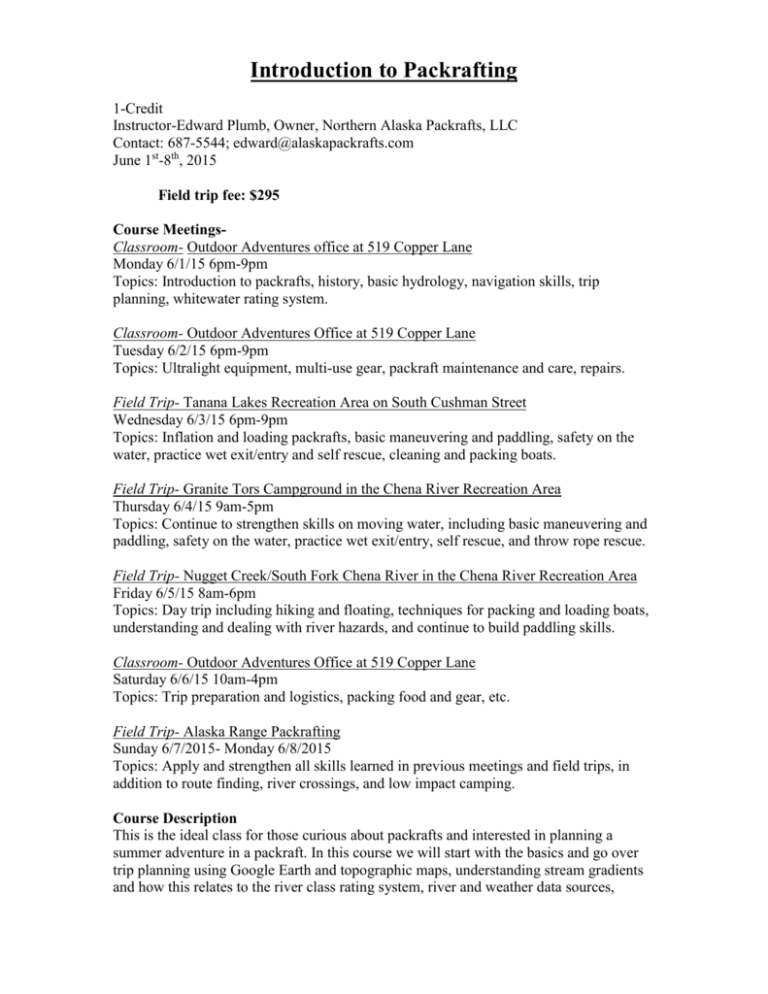
Introduction to Packrafting 1-Credit Instructor-Edward Plumb, Owner, Northern Alaska Packrafts, LLC Contact: 687-5544; edward@alaskapackrafts.com June 1st-8th, 2015 Field trip fee: $295 Course MeetingsClassroom- Outdoor Adventures office at 519 Copper Lane Monday 6/1/15 6pm-9pm Topics: Introduction to packrafts, history, basic hydrology, navigation skills, trip planning, whitewater rating system. Classroom- Outdoor Adventures Office at 519 Copper Lane Tuesday 6/2/15 6pm-9pm Topics: Ultralight equipment, multi-use gear, packraft maintenance and care, repairs. Field Trip- Tanana Lakes Recreation Area on South Cushman Street Wednesday 6/3/15 6pm-9pm Topics: Inflation and loading packrafts, basic maneuvering and paddling, safety on the water, practice wet exit/entry and self rescue, cleaning and packing boats. Field Trip- Granite Tors Campground in the Chena River Recreation Area Thursday 6/4/15 9am-5pm Topics: Continue to strengthen skills on moving water, including basic maneuvering and paddling, safety on the water, practice wet exit/entry, self rescue, and throw rope rescue. Field Trip- Nugget Creek/South Fork Chena River in the Chena River Recreation Area Friday 6/5/15 8am-6pm Topics: Day trip including hiking and floating, techniques for packing and loading boats, understanding and dealing with river hazards, and continue to build paddling skills. Classroom- Outdoor Adventures Office at 519 Copper Lane Saturday 6/6/15 10am-4pm Topics: Trip preparation and logistics, packing food and gear, etc. Field Trip- Alaska Range Packrafting Sunday 6/7/2015- Monday 6/8/2015 Topics: Apply and strengthen all skills learned in previous meetings and field trips, in addition to route finding, river crossings, and low impact camping. Course Description This is the ideal class for those curious about packrafts and interested in planning a summer adventure in a packraft. In this course we will start with the basics and go over trip planning using Google Earth and topographic maps, understanding stream gradients and how this relates to the river class rating system, river and weather data sources, packing techniques and tricks, ultra-light equipment and clothing to stay warm, learning about multiple uses for a single piece of gear, maintenance and repairs, inflation of the boat, loading your boat, basic maneuvering and paddling, wet exit/entry, self rescue, and emergency preparedness and safety on the water. We will then head out for two individual day trips on the Upper Chena River to practice and build our skills, and then combine everything we have learned in an overnight packrafting trip in the Alaska Range. This environment will provide many opportunities for instruction and learning moments. Course Goals The students should leave this course with a good understanding of packrafting in Alaska. This class will provide students with a background in trip planning, the types of multi-use gear needed for packrafting and its correct use in the field, and the necessary skills for safe travel on rivers and lakes. This class will help develop a good sense of judgment for future packrafting trips. In addition, students will experience firsthand how packrafting has revolutionized backcountry travel and will be eager to continuing exploring Alaska on their own in a packraft. Student Learning Outcomes Students should be able to plan a route, estimate whitewater class rating if unknown, and put together the logistics of their own packrafting trips. After this course students should be able to navigate in the wilderness with a map and compass, learn to recognize obstacles in the river, when to scout or portage, and understand their own personal level of comfort on the water. Students will know and be able to follow the Leave No Trace wilderness principles. Students will be able minimize their risk of a negative bear encounter by practicing bear safe procedures. Appropriate Student Background There are no prerequisites for this course; however, enrollees must be in adequate physical condition to carry a 30+ pound pack over uneven surfaces and be comfortable on the water and swimming in moving water. Students must be willing to: travel in inclement weather, bushwhack, have wet feet, do river crossings, deal with lots of bugs, and travel over steep and unstable terrain. Instructional Methods The course will use both classroom discussion and field learning. The classroom discussion will be prior to the field trips. During the field trips, the instructor will discuss potential situations and challenges as well as demonstrate skills to be mastered by the students. The students will then have time to learn/practice those skills through application by active participation in packrafting. The students will have a final scenario based on the skills learned in the class. Grading This is a pass/fail course. Trip Preparation 25% Field Scenarios (navigation, campsite selection, route finding, etc.) 25% Field Notebooks 25% Participation in the expedition experience 25% 70%- will be considered a passing grade Grading Rubric for Intro to Packrafting Trip Preparation Field Scenarios Field Notebook Participation in the Expedition Experience 5 (Excellent) Student has their personal gear kit for the trip together, organized and complete. Student works hard to make sure that the food, logistics and group gear are thoroughly prepared 4 (Good) Student has most of their personal gear together. Student actively participants in food shopping, logistics and group gear participation 2-3 (Fair) Student has an incomplete or unorganized personal gear kit. They don’t do their share of the pre-trip preparations with the group food and gear. Student fully grasps the concepts presented in LNT, navigation, route finding and other field lessons and can then implement them on their own Student fully utilizes the field note book for taking notes and checking lists before the trip, thoughts and reflections in the field and also has notes taken during the field scenarios Student engages with the group in a positive manner. They pitch in and do more than their share of the camp chores. They also are encouraging and patient with other members of the group Student has a good grasp of the field concepts that are presented and can demonstrate these concepts with a little help Student takes some notes in the notebook about the trip prep and lesson and also writes some reflections while out on the trip. Student has a partial understanding of the different field scenarios and has trouble demonstrating any of those lessons. 0-1 (Poor) Student has not taken the necessary steps to get any of their gear together. They are absent from the trip preparation or don’t do anything to make the logistics for the trip happen Student has no grasp of the field concept lesson that are presented and can’t demonstrate any of them without significant help Student has a notebook but doesn’t use it much Student doesn’t have a field notebook Students are positive and helpful most of the time. They do their share of the camp chores and participate in the decisions that the group makes Student is sometimes unengaged or negative with other members of the group. They only participate in some of the group discussions and mainly do camp chores that benefit themselves directly. Student is not engaged with the group at all. Never does any camp chores and is negative, sullen and makes no effort to resolve any issues within the group Equipment Outdoor Adventures will provide: drysuits, PFD’s, throw ropes, dry bags, tents, backpacks, sleeping bags, sleeping pads, stoves, and pots. Northern Alaska Packrafts will provide: packrafts, paddles, and boat inflation bags. Students will need to have clothing that is appropriate for being outside in the summer environment of Alaska. Course Material There is no text book. Students will need to have a field notebook and pencil for the course. Course Assignments Students will be expected use the notebook to create a future reference for safe packrafting and backcountry travel. This should include: documenting river levels at the start/end of the trip, the type of water encountered at that water level, relationship of stream gradients to the whitewater rating class, location of any hazards observed on the river for future reference, types of multi-use gear, notes about food choices including likes/dislikes and amounts, daily distances and times, route hints and reminders for next time, general reminder notes, and reflections about the trip (I.E. why you are there?). Risk Tolerance Due to the nature of outdoor travel there are certain risks in this class. Acceptable risks include: hazards in the river such as sweepers/strainers, rocks or other obstacles in the water, rapids, submersion in cold water, swimming, hiking up steep hills with a backpack of 30+ pounds for many miles of rough terrain, doing stream crossings, camping out in Alaska weather, dealing with wildlife, snowstorms, wind, ice and mud. Driving risks may include slick and snowy roads, poor visibility, and wildlife. Students with Disabilities The Office of Disability Services implements the Americans with Disabilities Act (ADA), and insures that UAF students have equal access to the campus and course materials. The instructor will work with the Office of Disabilities Services (203 WHIT, 474-7043) to provide reasonable accommodation to students with disabilities. Please inform the instructor of any disabilities during the first class session.



